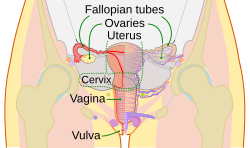CANCER DIGEST – July 12, 2016 – Ovarian cancer most often starts in the fallopian tubes, an observation that caused the American College of Obstetricians and Gynecologists (ACOG) to issue an opinion in January 2015 recommending that women undergoing hysterectomies for non-cancerous conditions should also have the fallopian tubes removed, while sparing the ovaries as a way to prevent ovarian cancer.
In issuing their opinion, the ACOG acknowledged that randomized controlled clinical trials are needed to determine if salpingectomy, or removing fallopian tubes, does reduce ovarian cancer risk.
Until then, Kaiser Permanente, a large health maintenance organization in California, implemented a program to adopt the ACOG’s recommendation to increase salpingectomy among providers performing hysterectomy for other medical reasons.
In a study of 12,143 hysterectomies in the journal Obstetrics & Gynecology published online ahead of print, the researchers led by C. Bethan Powell, MD, report that widespread adoption of the procedure in a large, health care system is possible following a systemwide education program.
The study compared the percentage of salpingectomies in the June 2011 to May 2012 period before the education program to the number performed between June 2013 and May 2014 after the program.
They found that the percentage of salpingectomies increased from 14.7 percent before, to 72.7 percent after the education program. They also found that on average the surgery to remove the uterus and fallopian tubes took 7 minutes less than hysterectomies that did not remove the fallopian tubes. In addition 91 percent of the surgeons who performed the salpingectomy reported no additional complications.



No comments:
Post a Comment